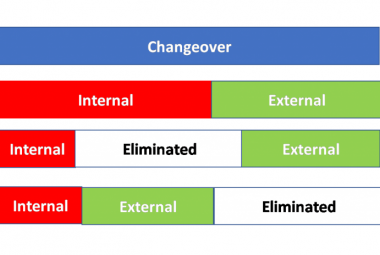In the first article in this series, I introduced 5S as the tool to improve productivity in your process. In the second artile, we dived deeper into the first 2 phases of 5S: Sorting and Straightening. In this article, the 3rd and 4th phase are described: Sweeping and Standardising.
The third stage is SWEEPING, which is an activity that employees would be either partly or completely responsible for, depending on the nature and scale of the workplace.
Each team or individual involved should have his or her own dedicated machines or workstations to clean at routine periodic intervals. Sweeping is therefore an ongoing activity, not a single, one-time event. Having machines cleaned (and possibly even maintained) by operators using them is important because nobody other than the operator is likely to know a machine better than the operator who uses it on a daily basis.
One of the biggest benefits that comes from having operators in the habit of regularly cleaning their assigned machines and/or workstations is that these operators are more likely to discover small abnormalities that happen to emerge in use, before they result in producing defects. This means, that the goal of the sweeping stage is not just cleaning the machine, but it sets the stage for the practice of operators responding to deviations from the standard, which is the most important practice within lean thinking and behaving.
Within a manufacturing facility, different work areas can be designated with different colors on a lay-out overview of the facility, to demonstrate which team or individual is responsible for which area.
Cleaning a machine only once does constitute an acceptable 5S standard. Practicing sweeping is about defining a cleaning schedule that is most appropriate to making sure that the machines or working areas are always in a proper working order, thereby helping to prevent of avoid possible defects and/or delays.
The same is true for tools on the shadow board. Depending on what industry you are working in, a slightly damaged tool can have a major impact on the quality of your product and on the productivity of your production. It is therefore important to discuss what interval and level of cleaning is necessary in your specific situation.
Carrying out the sweeping stage in any factory can sometimes be a controversial topic, leading to discussions among employees on how best to perform this activity. Keeping the workplace clean is clearly a desirable endeavor and it’s an important part of making the 5S model work as intended; particularly when it comes to attaining and sustaining the highest quality levels for the products and/or services being offered to customers.
The time spent on cleaning machines and even floors however, negatively impacts the efficiency of the process on the short term. Spending time cleaning 30 minutes today will cost me 30 minutes of production time today. The challenge will therefore be to design a cleaning schedule that balances the time we invest in cleaning proactively, with the time it saves in the future in terms of less quality issues.
Though cleaning the machine might be related to the technical skills of the employee working there, cleaning the floor is usually not considered a value adding task by the machine operator even though it may still have an impact on your product quality. Who does what part of the cleaning is therefore also a topic of discussion.
Next to the discussion on who does what cleaning and how often, there should also be a focus on reducing the time that is necessary to keep the workplace clean. We will come back to this during the sustain step.
The fourth S in the overall practice of 5S is the STANDARDIZING stage. As with every other agreement on the way of working, the layout and organizational agreements of the workplace should be recorded in the standard.
There is an important distinction that needs to be made between something that is standardized and something that is a standard. The former involves making a practice/procedure something that can be performed in the same or very similar manner anywhere and anytime it is being performed. A good example is when it comes to standardizing all 5S practices throughout a facility. In contrast, a standard is something that helps ensure that a specific desired/targeted level of quality and/or performance can be achieved as a result of following the specified standard which often contains specified procedures and/or metrics that must be met.
Also, it’s important to realize that both a standardized practice and a standard can be changed over time as necessary. The ability to pursue and make improvements demands that both be changeable whenever a better way or a higher level of performance is desired.
When it comes to specifying a workplace standard for cleanliness and organization, it usually suffices to post a picture of the workplace or part of the workplace, along with a sweeping schedule.
It is also good practice to visualize all 3F (fixed place, fixed part, fixed quantity) information on the floor or walls within the dedicated lines. Again, the main goal of 5S is elevate the ability for any observer to identify abnormalities as soon as possible. For instance, when a designated location is empty, we would like to know what is missing and why.
Figure 3: two examples of a 5S standard (SOURCE: Panneman, 2019)
The publications of the 5S standards meets that need. Figure 3 shows two pictures of various 5S standards in practice at two of the factories I worked at in the past. The left example has 4 pictures (of different corners) of a working area in its standardized configuration. Because this standard is posted at the working area, an operator (or anyone) can make the comparison between the current condition of the work area and how it is supposed to be maintained.
In the example on the right, there is only one picture on the document, but it also includes a list of the critical items for that area and a sweeping schedule. An added benefit that comes from having clearly documented standards, (which in the above examples were one-pagers), is that they can be used as training aids when it comes to training new operators on how the workplace is organized and why it needs to be maintained in that condition.
Finally, the established 5S standards (like all standards) will serve as a starting point for the pursuing the practice continuous improvement. Only when there is a well-documented standard of the current state of the workplace (as agreed upon by all team members), can improvements to the standard be discussed. This is because if there is no standard as a starting point for the discussion, team members might be either improving something that is not supposed to be done in the first place or improving something that was already standardized by others in the past.
Improvements might include the need for fewer tools at a workstation, an improvement of ergonomics, or a reduction of the time needed to keep the workstation clean.
Continue to:
REFERENCE:
Panneman, T., 2019, Sustainable 5S - How to Use the lean Starting Tool Tool to Improve Flow, Productivity and Employee Satisfaction, Dublin: MudaMasters (summary / order this book)











